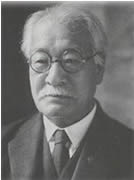- Tokutomi Sohō
Infobox Writer
name = Tokutomi Soho

caption =
birthdate = birth date|1863|3|14|df=y
birthplace =Minamata, Kumamoto Japan
deathdate = death date and age|1957|11|2|1863|3|14|df=y
deathplace =Atami, Shizuoka ,Japan
occupation = Journalist, Historian
genre = essays
movement =
notableworks =
influences =
influenced = nihongo|Sohō Tokutomi|徳富蘇峰|Tokutomi Sohō|extra=14 March 1863 —2 November 1957 was thepen-name of a journalist and historian active from lateMeiji period through mid-Showa period Japan . His real name was Tokutomi Iichiro. He was the older brother of noted author Tokutomi Roka.Biography
Sohō was born in Minamata,
Higo province (present dayKumamoto prefecture to asamurai - ranked family just before theMeiji Restoration . He studied "rangaku " at the "Kumamoto Yogakko", and later at the "Doshisha" (subsequentlyDoshisha University ) inKyoto . He left school without graduating, but later wrote of his gratitude to the school's principal,Joseph Hardy Neesima .Following a period back in Kumamoto, where he started a local
newspaper , Sohō moved toTokyo . In 1887, he established the Min'yusha publishing company, which printed Japan's first generalnews magazine , the "Kokumin no Tomo" ("The People's Friend") from 1887-1898. This magazine was highly influential in the politics of Meiji period Japan. In addition to this news magazine, the Min'yusha also published a general magazine, "Katei zasshi" ("Home Journal", 1892-1898), an Englishlanguage translation of the "Kokumin no Tomo", ("The Far East", 1896-1898), and an influential newspaper, the "Kokumin shimbun" (1890-1929).Sohō was initially a champion of
liberal democracy andpopulism , as he felt that a free, open and democratic social and political order in emulation of the western nations in general, and theUnited States in particular would enable Japan to modernize and strength itself in the shortest possible time. His newspapers and magazines were in a thorn in the side of the government during the administration ofMatsukata Masayoshi , criticizing the numerous corruption scandals of the time. However, following theFirst Sino-Japanese War and theTriple Intervention , his political views moved to the right of the political spectrum. By the 1890s, he came to be regarded as a conservative champion of theMeiji oligarchy , and was a close confidant of Prime MinistersYamagata Aritomo andKatsura Taro . By 1905, the "Kokumin Shimbun" was regarded as a government mouthpiece, and as such, its offices were targets of protesters during theHibiya riots .In 1910, Sohō founded the "
Keijo Nippo ," one of the major Japanese newspapers inKorea under Japanese rule .While overseeing these publications as general editor, Sohō contributed some 350 articles, on diverse subjects ranging from international affairs, to history, biography and literature. He also compiled "Kinsei Nihon Kokumin shi" ("A History of Early Modern Japan"), which was published in 100 volumes over a period from 1918-1952. He was awarded the
Order of Culture by the Japanese government in 1943.Sohō was viewed with suspicion by the American occupation authorities, and was held under arrest during the occupation of Japan from December 1945 to August 1947 as a
Class A War Criminal . The charges never came to trial (partly because of his age—he was 82 at the time), and he spent the time underhouse arrest at his villa in Atami. He continued to live in Atami until his death.External links
* [http://www2.ocn.ne.jp/~tsoho/index.html Tokutomo Soho Memorial Museum (Japanese)]
* [http://www.town.mashiki.kumamoto.jp/content/asp/kiji/kiji_detail.asp?PageID=12&Knum=46&tpg=2&PageType=k_list Tokutomi Soho Museum in Kumamoto]
* [http://www.findagrave.com/cgi-bin/fg.cgi?page=gr&GRid=6617751 Find-A-Grave biography]References
* Pierson, John D. "Tokutomi Soho 1863-1957: A Journalist for Modern Japan". Princeton University Press (1980). ISBN 0691046743
* Ariyama Teruo. "Tokutomi Soho to Kokumin shinbun". Yoshikawa Kobunkan. ISBN 4642036318 (Japanese)
Wikimedia Foundation. 2010.
